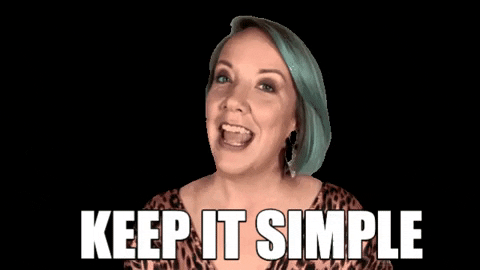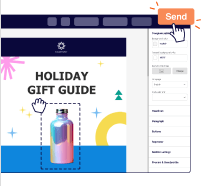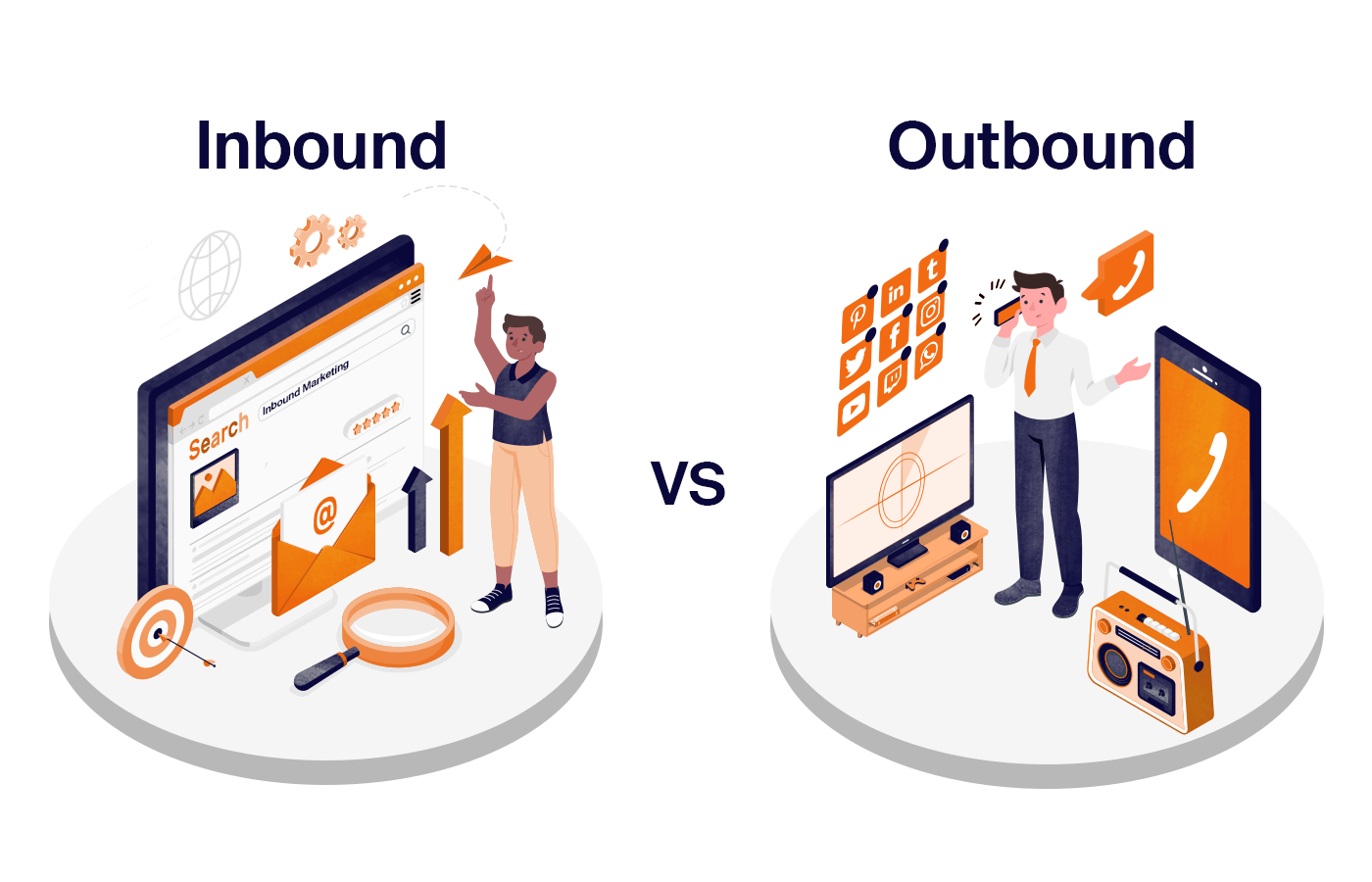What’s with the whole Inbound vs Outbound sales stuff? End of the day, isn’t it just sales after all?
You are right!
Whichever way you look at it, a sale is a sale and brings in revenue.

However, without even knowing it, you may be relying on one type of sales (maybe inside or outside) over another because of the results it is bringing your industry in general or business specifically. Also, many a time, one way of selling works better than the others.
Let’s understand why the distinction is important and why they both work differently.
What exactly is the Difference — Inbound vs Outbound Sales?
The primary difference between inbound and outbound sales is answered when you answer the critical question — “who made the first move?”.
Inbound sales are when a prospect comes inquiring about a possible product, service, or solution.
On the other hand, the definition of outbound sales is that it is the type of interaction that happens when your sales team “outreaches” target prospects educating them about how the product or service being offered by your business can potentially solve the prospect’s problems or make their life better.
In simple terms, in Inbound sales, “inquiries” pop in from interested prospects, while in Outbound sales, your team “solicits” buying interest.
“Inbound” sales can be thought of as helping product more “warm” leads since they’ve already been reading up about your business and what it offers; while “Outbound” sales generally produces “cold” leads as they are not aware of what you do and if they even need your product or service in the first place!
While it’s easy to think of “inbound” as a marketing function and “outbound” as a sales outreach activity, things are slightly more complex in the real world.
Some Interesting Inbound and Outbound Sales Statistics
- 75% of surveyed executives are willing to make an appointment or attend an event based on a cold call or email alone (by DiscoverOrg).
- 77% of B2B purchasers said that they would not even speak to a salesperson until they had done their own research (by The Corporate Executive Board).
Obvious neither of these strategies is dead so that just makes up for a fascinating discussion up ahead.
Examples of Inbound Sales Strategies
- Highly informative blog post articles
- Valuable, educative marketing collaterals such as ebooks, downloadable guides, case studies, whitepapers
- Free trial software
- Cheatsheets, calculators
- Free training
- Free consultation
- Training videos
- Webinars, podcasts
Examples of Outbound Sales Strategies
- Outbound sales calling by a call center rep or telemarketing department
- (Cold) outreach emails
- Social selling
Building a Strong Inbound and Outbound Sales Strategies
Typical elements of a robust sales process would include:
- Overall Organizational Goals & KPI (Key Performance Indicators) setting
It is essential to plan and plot where you would like to go forward at the organizational level. Once this is clear, it translates into exact expectations from the sales and marketing teams. These are usually in the form of quantifiable and measurable metrics called Key Performance Indicators (KPIs). - Buyer Research
Often the most critical part of sales, you should have critical information about your prospect. All this information can be plotted in the form of internal documents such as Buyer Persona, Ideal Customer Profile (ICP), Buyer’s journey roadmap, etc. - Process
The overall process and methodology should be repeatable one, so everyone knows what to do and how. Often a critical part of processes is the “training” aspect, where your skills are honed so that you can do newer things or do the same things better. - Tools
In an increasingly automated and data-driven world, the importance of having the right tools such as CRM software, email marketing software (Sender is a great option), dialer software, etc., cannot ever be underestimated. - Reporting
It is vital to have a solid data-driven mindset when trying to analyze the results. What is being tracked, Why does it need to be tracked, and How often does it need to be tracked (cadence), etc., are crucial decisions as these act as your compass to help your business move in the right direction forward.
Inbound Sales Process
The inbound sales process is straightforward.
- Identify your prospect by creating a Buyer Persona document
- Analyze the problems and pain points of your prospect; especially those that are highly relevant to the product or service you offer
- Analyze the customer’s buying journey to understand how they could possibly end up deciding to buy a product or service, such as the one you are marketing.
- Create high-quality educational and/ or entertaining content that talks about these problems and possible solutions. Briefly mention your solution too.
- Distribution through organic (social posts, SEO) and inorganic (paid ads) help take this content and places them in front of your target audience.
- Handle inquiries from prospects gently, getting them deeper in your funnel.
Outbound Sales Process
- Outreach potential customers as indicated by your Buyer Persona or Ideal Customer Profile (ICP) documents.
- Use automation and sales CRM tools to enable better efficiencies and effectiveness, e.g., dialers to enable you to reach more “real people” or email automation to set up nurturing automation.
- Qualify prospects, and if your sales CRM allows you to lead score them, go ahead and do that by all means. This allows you to focus more time and effort on leads that are likely to convert faster and convert first.
- The ever-important Sales Pitch & Handling Objections
- Closing the Deal by asking for a Sale
Inbound Sales Pros and Cons
Pros
- Because the prospect has already gone through your online presence (website, blog, podcast, etc.), your business is looked upon with higher trust and credibility.
- Inbound marketing campaigns on the surface boast of higher conversion rates since inbound sales typically provides higher quality leads, i.e., prospects more like to convert into paying customers.
- Depending on how you do it, Inbound marketing is generally considered low-cost.
- Less requirement for a sales workforce with specialized training, e.g., cold calling, etc.
- Works excellent for low-to-medium cost products and services.
- Execute once, Benefit Multiple times – The initial effort required to set up inbound assets is monumental. Still, over a period of time, minimal effort is needed to maintain and update them.
Cons
- Most inbound sales tactics do not produce immediate results. Instead, they work with a medium to long-term outlook. Therefore, managing your expectations is crucial.
- Time-consuming – It takes time to set up and optimize inbound marketing elements. E.g., researching, writing, publishing, and SEO-optimizing blog articles.
- Resource-intensive – More often than not, you need access to experts who can do this for you. E.g., Content writers, SEO Copywriters, etc.
Outbound Sales Pros and Cons
Pros
- Immediate results – If your business needs sales & revenue immediately, inbound marketing is definitely NOT the answer. However, outbound sales can provide quick wins and inject some much-needed “oxygen” into your business ecosystem.
- Predictable to Scale – If you have a well-established and tested outbound sales process, the beauty of it is how predictably (almost like clockwork) it plays out! When you know approximately how much sales will result from adding one more outbound sales representative, you know how fast you can scale and what impact this will have on the bottom line.
- Specificity – Need the Vice President of Marketing at Google to pay attention to your business? Good luck with inbound tactics! The best way to get in touch with high-value targets is through outbound processes!
Cons
- “Colder” leads – expect to end up talking to prospects, most of whom have absolutely no idea of what you do, or even about their own problems in the first place. So have strong objection handling scripts that address virtually any and all questions a prospect could have.
- More friction – regardless of how much you sweet-talk yourself into believing otherwise, outbound sales is an intrusive mechanism involving a lot of friction. You have no idea of what your prospect is doing when you cold call or email him.
The idea is to keep it as least abrasive as possible through solid scripts and spiels (with well-curated interview questions), evolved best practices for follow-up cadence, etc. - Outbound sales is a continuous process. The moment you ‘close the tap,’ so to speak, leads dry up almost immediately. Inbound sales, on the contrary, has a more trickle-down effect over a more extended period
Using the Right Email Marketing Tool
Most of your sales will not happen immediately. All of your leads will undergo a nurturing sequence at some point, usually over emails, so it is important that you choose a tool that:
- Helps you capture leads using popups & sign-up forms.
- Allows you to manage inbound and outbound leads inside a CRM-like interface.
- Makes it simple to set up trigger-based automation emails and newsletters.
- Supports hyper-personalization to ensure that your prospect feels like you are writing only to them!
Sender helps you do all of these and you don’t need to bother with a complicated setup.
How to Choose Inbound vs Outbound for Your Business?
The best answer as usual — it depends, my friend!
Neither approach is inherently better. However, both techniques can be powerful tools for growing a company.
The sales strategy you should use will depend on a number of variables. Some of the questions you should be asking yourself include:
- Timeline – How soon do we want this sales process to give us leads? How dependent is my business on this revenue immediately?
- Deal Size – What is the deal size?
- Which approach will give me a higher ROI?
- How do my prospects usually end up buying a product such as mine? E.g., do they execute a google search and look at reviews first versus hop into a one-to-one call with your consultant after a simple cold email?
- What is working great for my competitors and others in my industry or niche? Who seems to be doing well?
Tips & Use Cases for Choosing Inbound vs Outbound Sales
Choose Inbound Sales when:
- You have a product, service, or problem that people search for a lot online.
- You are not ready to invest in strong sales systems and dedicated sales professionals.
- You’re able to strategize and implement a strong content marketing strategy. This includes making available time (if your internal team is involved) or money (if content aspects are outsourced).
Choose Outbound Sales when:
- Your product is high-ticket, and/ or your clients are enterprise or B2B.
- Your product or service has a longer sales cycle.
- You want immediate results.
- You are willing to invest money and test the viability of your product or service.
- You’ve got a clear target profile – E.g., VP and higher-level executives of all IT Service companies for you to sell your product to.
You will need multiple iterations to get the right formula for your business. Obviously, it’s been said before, and we say it again — go with what the data says and what results ultimately say!
The Final Verdict – Inbound vs Outbound Sales
If you primarily follow an inbound strategy but cannot get the results you want, use outbound to generate some quick wins.
If you follow an outbound sales strategy but seeing poor-quality leads coming through often, consider investing in inbound marketing to filter and attract better-qualified leads.
The real boardroom debate for most businesses is never “inbound vs outbound sales.” Instead, it is how much inbound and how much outbound to get the job done.
Article contributor – Santosh Balakrishnan

